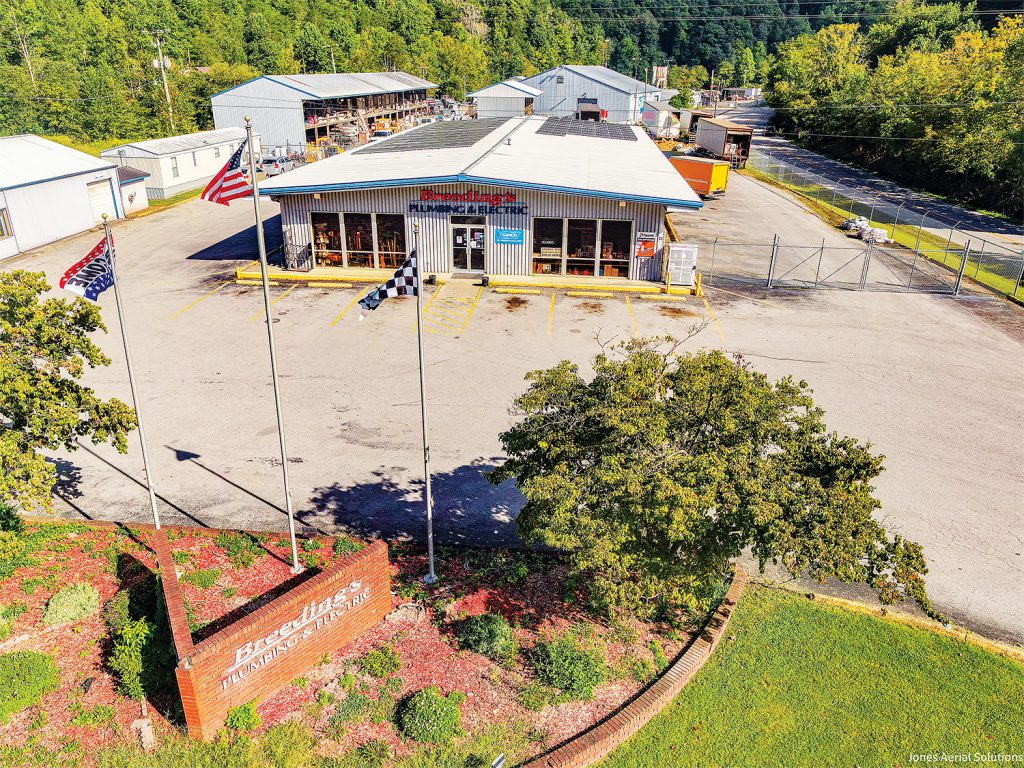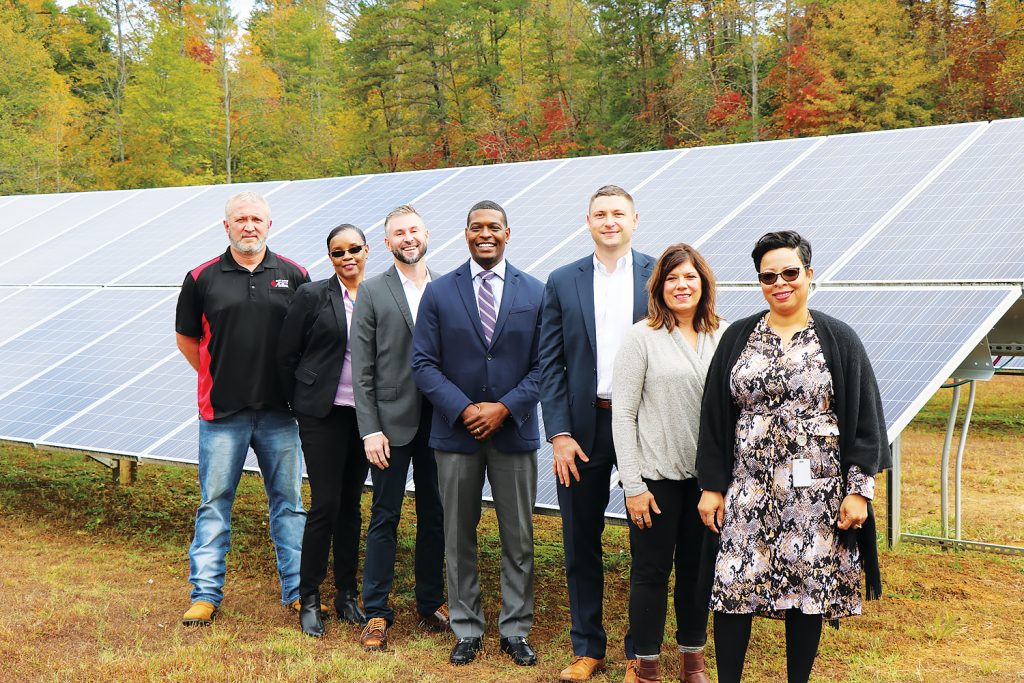REAP Benefits Farmers, Small Businesses and the Climate

Annie’s Frugal Finery in Whitesburg applied for REAP funding for a solar array. Photo courtesy of Mountain Association
By Megan Pettey
In 2019 Thatchmore Farm, an organic fruit and vegetable producer in Leicester, North Carolina, installed a solar panel array to power three heated greenhouses, a well pump and a produce cooler on their 10-acre farm. While installing the panels cost $33,000, a federal program helped make it possible for this small, family-owned business to afford the clean energy project.
For 15 years, farmers and small businesses trying to save on energy costs have gotten a boost from the Rural Energy for America Program, the U.S. Department of Agriculture initiative commonly referred to as REAP, which helps fund energy efficiency improvements and renewable energy systems. Now, a sizable boost in funding from the 2022 Inflation Reduction Act has significantly amplified the program’s ability to finance clean energy projects in rural communities.
The 2022 law invests in domestic energy production with an emphasis on renewable energy, which is tied into President Joe Biden’s pledge to reduce greenhouse gas emissions at least 50% below the 2005 level by 2030. As one of several clean energy programs receiving funding from the bill, REAP provides grants and loans to agricultural producers and small businesses in rural areas to help them install renewable energy systems or make energy efficiency improvements.
Projects that fall under the renewable energy systems side of REAP include biomass, geothermal, hydrogen, hydropower, small and large wind generation, small and large solar generation and ocean generation. On the energy efficiency front, program funds can be used to install ventilation and air conditioning systems, insulation, lighting, doors and windows, refrigeration units and to replace energy-inefficient equipment.
For example, REAP funded 25% of a 432-panel solar array in Caldwell County, North Carolina, as part of rural electric cooperative Blue Ridge Energy’s Kings Creek community solar project completed in 2019.
Most of the current REAP projects are focused on solar energy, according to Carrie Ray, energy programs coordinator at the nonprofit organization Mountain Association. Ray helps a variety of clients in Eastern Kentucky complete REAP grant applications, which involve lengthy forms and paperwork that Ray says a lot of small businesses aren’t equipped to handle by themselves.
In 2021, Mountain Association assisted several Eastern Kentucky businesses with obtaining REAP funding, including Pantry Shelf Grocery, Longview Estate, Red River Harvest Inn, Sunhouse Craft, HomeGrown HideAways and multiple farms that received grants for renewable energy projects. Solar upgrades are the most common among applications, according to Ray.

Mountain Association has helped many Kentucky businesses, including Breeding’s Plumbing & Electric apply for REAP funding. Photo courtesy of Mountain Association
“We’re seeing far more applications for solar than for efficiency, and I think some of that is there’s other incentives for solar, the tax credit being one,” Ray says, referring to a federal solar tax credit recently extended for 10 years. “So folks could theoretically, depending on where they’re located, between the REAP grant and the tax credit, get 90% of their solar project covered by incentives. So that makes a pretty fantastic return on investment.”
These projects are beneficial not only in lowering utility bills for small businesses and agricultural producers, but also by decreasing overall power consumption, according to Ryan Thorn, West Virginia rural development state director for the USDA.
“These energy efficiency investments and these renewable energy investments, just in themselves, help reduce the amount of energy that is demanded from the grid,” Thorn says.
REAP grants are administered on a competitive basis for those eligible, with applications opening quarterly each year. Farmers who receive 50% or more of their income from agricultural operations and small businesses in rural areas with populations of 50,000 or less are able to apply. Small businesses can check the database website to see if they’re in a qualifying area, however agricultural producers applying for REAP are eligible whether or not they’re in a rural area.
IRA Expands the Program
A little over $1 billion in funding from the Inflation Reduction Act goes towards REAP through fiscal year 2031,which has greatly increased the number of grants the program can finance. Prior To the IRA, REAP grants were capped at 25% percent of a project’s cost. As a result of the bill, grants are now capped at 50%, up to $500,000 for an energy efficiency project or up to $1 million for a renewable energy project.
Robert Kerns, public information officer at USDA Rural Development, explains that this substantial boost likely incentivizes more applicants to complete renewable energy and energy efficiency improvements because less capital investment is required, making projects that might have previously been unfeasible affordable.
Both USDA Virginia State Director Perry Hickman and his West Virginia counterpart Thorn say they’ve seen a surge in applications this fiscal year in their respective states, which they attribute to the new law. Hickman says there were 37 REAP grant applications totaling over $3 million in financial assistance in 2023 compared to just 13 grant applications totaling approximately $800,000 for 2022. West Virginia has seen a similar increase in applications, according to Thorn.
“Thanks to the Inflation Reduction Act, the state allocation we received has nearly quadrupled, and in speaking with our energy coordinator, I know that we received probably 10 or 15 more applications just in that round than we did all of last year,” Thorn says.
Barriers to the Benefits
Despite the increase in REAP applications, a number of obstacles still stand in the way of farmers and small businesses benefitting from the program. An energy audit is required for those applying for energy improvements to prove the project would actually help the applicant save on energy costs. Energy audits are a necessary step to ensure these investments are worthwhile, and the cost of these audits can also be covered by REAP grants. However, only a limited number of certified organizations are able to perform the required assessment.

Representatives from Blue Ridge Energy, Blue Ridge Community Action and the North Carolina Department of Environmental Quality gathered in 2019 at a Blue Ridge Energy community solar array funded in part by the Rural Energy for America Program. Photo courtesy of Blue Ridge Energy
Hickman proposes applicants reach out to various entities that may be able to help with the energy assessment process, such as a local utility company or university, or an entity from the website of Association of Energy Engineers.
Additionally, Thorn is hopeful that the state of West Virginia will soon receive funding that will increase the capacity of available organizations who can perform energy audits, which would alleviate some of the barriers for applicants that need these assessments.
The REAP application process itself is also a hassle for many small businesses, according to Ray.
“Federal applications are tough,” Ray says. “There’s a lot of paperwork and bureaucracy and they need all of this information, just lots of forms to fill out and everything and this is something that most small businesses are not equipped to do.”
With the Inflation Reduction Act generating increased interest in the program, Ray says the demand for REAP outweighs the number of people available to aid with grant preparation, meaning Mountain Association currently has a lengthy waitlist of clients requesting assistance. Though there are larger firms that can provide the same service, according to Ray, they charge thousands of dollars, which far exceeds the budget of small businesses looking for their help.
The USDA launched a REAP Technical Assistance Grant in July 2023 to help applicants from disadvantaged communities, projects under $20,000 and projects using underutilized renewable energy technologies.
“It’s smaller communities, smaller businesses, nonprofits, places that don’t have federal grant writers on staff can miss out on these opportunities just because they don’t have anybody to help them figure it out,” Ray says. “So if there were federal resources to help folks, again outside of the REAP grant, but just overall to figure out how to write grants and navigate the bureaucracy that’s involved, I think that would make a really big difference.”
For more information about the RuralEnergy for America Program and how to apply, visit the USDA Rural Development Website. Those looking for assistance in applying to the program can reach out to the energy coordinator for their state.
Editor’s note, Aug. 28, 2023: A U.S. House Appropriations bill, H.R. 4368, would cut the Rural Energy for America Program by $500 million. Appalachian Voices is urging Congress to reject this and other proposed cuts to programs that benefit rural Appalachian communities.
Related Articles
Latest News
More Stories

Leave a comment
Your email address will not be published. Required fields are marked *





Leave a Comment